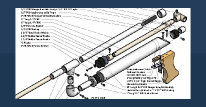
Welcome to Nerf Engineering
#1

Posted 25 February 2014 - 09:57 PM
Now it's a column titled Nerf Engineering in the articles section here at NerfHaven. The focus and goal are the same, but the audience is much larger. Despite that, I will make no attempt to dumb down the content. I write for someone in college or older. Some background in calculus will be required for some posts.
Expect a post every week or two. I have a large backlog of topics I've already analyzed, but have not written about in usable form. You can post requests here, in this thread, for now.
All posts here will potentially be updated after their original posting. The date of last update will be listed at the bottom of the post.
#3

Posted 25 February 2014 - 11:28 PM
#4

Posted 26 February 2014 - 10:05 AM
#5

Posted 26 February 2014 - 01:24 PM
Looking forward to the Flywheel lecture.
#6

Posted 26 February 2014 - 02:15 PM
#7

Posted 26 February 2014 - 02:58 PM
This way, we can use the drag force and gravity to create another formula to get an approximate range from Chronograph readings. This would only work for accurate darts, though. So not for streamlines.
I think the best way to find the drag coefficient would be to drop a dart with the same reference area as a standard slug dart with known mass and from a known height. Timing the drop should get a proper coefficient (If I understand it correctly).
#8

Posted 26 February 2014 - 05:25 PM
Edited by Ivan S, 26 February 2014 - 05:30 PM.
~Talio
#9

Posted 26 February 2014 - 11:35 PM
Are you going to be taking attendance, do we need to print out a copy of the syllabus, and when is the first exam?
I find this to be amusing.
Looking forward to the Flywheel lecture.
I'd like to second the request for a flywheel post. There's little to no knowledge in the community as to how variables like wheel mass, moment of inertia, and motor torque affect performance. If we could get a Real Life Physicist to teach us the basics it could really help people who want to build their own.
I know little to nothing about flywheels, but they certainly are within my skillset. I'll take a closer look. Feel free to post some more information here if there's anything in particular that you find interesting (like, for example, someone else's thoughts about flywheels) or other particular questions you might have about flywheels.
I would recommend lecturing about shady ass generic Chinese valves. They are fairly difficult to come across any factual information about them.
Valves in general have a lot of issues. I'll take a closer look at this. I do know the Asian valves tend to use a different test method than the American ones, which adds to the confusion when you do have some information.
If you haven't, calculate the approximate drag force of a micro dart in terms of velocity (in ft/s for use with chronographs) and mass (in grams).
This way, we can use the drag force and gravity to create another formula to get an approximate range from Chronograph readings. This would only work for accurate darts, though. So not for streamlines.
All this has basically been done, though it's not well organized. See this old blog post about drag for the drag coefficient of a Nerf dart and similar shapes and my old ballistics notes for some equations to estimate range. One of my plans is to take that earlier blog post and some appropriate sections of my notes and expand on them in a larger post. I'd like to make an online calculator for range, too.
#10

Posted 19 March 2014 - 12:11 AM
If you haven't, calculate the approximate drag force of a micro dart in terms of velocity (in ft/s for use with chronographs) and mass (in grams).
This way, we can use the drag force and gravity to create another formula to get an approximate range from Chronograph readings. This would only work for accurate darts, though. So not for streamlines.
I think the best way to find the drag coefficient would be to drop a dart with the same reference area as a standard slug dart with known mass and from a known height. Timing the drop should get a proper coefficient (If I understand it correctly).
Hmmm. I was writing a ballistics program to calculate ranges at different angles and such. If I had a decent value on the drag coefficient of various NERF darts I could make a few tables/graphs for reference.
#11

Posted 19 March 2014 - 05:50 PM
Hmmm. I was writing a ballistics program to calculate ranges at different angles and such. If I had a decent value on the drag coefficient of various NERF darts I could make a few tables/graphs for reference.
Sounds nice. In the post directly prior to yours, I linked to an earlier blog post of mine where I summarized the available drag data: http://btrettel.nerf...com/archives/78
Based on tests done by Daniel Beaver and koree, I would suggest using a value of 0.67 for the drag coefficient. This value fits my flat-fire (small angle) approximate theory very well and is in concordance with wind tunnel tests done for circular cylinders with flat and smooth noses.
You can read more about the flat-fire theory in my old notes: http://trettel.org/p...stics-notes.pdf
#12

Posted 21 March 2014 - 01:12 PM
Sounds nice. In the post directly prior to yours, I linked to an earlier blog post of mine where I summarized the available drag data: http://btrettel.nerf...com/archives/78
Based on tests done by Daniel Beaver and koree, I would suggest using a value of 0.67 for the drag coefficient. This value fits my flat-fire (small angle) approximate theory very well and is in concordance with wind tunnel tests done for circular cylinders with flat and smooth noses.
You can read more about the flat-fire theory in my old notes: http://trettel.org/p...stics-notes.pdf
Oh thank you! Sorry I missed that. I'll see what I can do about that range table, though it'll need to be proofread in real testing.
#13

Posted 23 March 2014 - 10:25 PM
Everyone hates engineers because they listen to what you say and then think about it.
Check out my YouTube!
#14

Posted 24 March 2014 - 10:18 PM
I would say that coefficients of friction for various brands of FBR on various brands of CPVC would be a good idea, but there is probably far too much inconsistency for useable data to be accumulated. Perhaps some common match ups could be outlined if a universal barrel length formula is ever created.
Friction measurements are one thing we seriously lack. The problem in Nerf is actually worse than you might imagine. The friction force is a function of the coefficient of friction and the normal force. Neither is known. Roughly, what we do know is that tighter barrels will have higher normal force and that some materials have less friction than others.
I recall discussing some ways to estimate the friction force with Split a while back. He used the bulk modulus to estimate the normal force. I suggested something more complicated that probably would not be much more accurate than his approach. I should look more closely into this.
Spud gunners use a simulator called GGDT which allows you to specify the total friction pressure, which I call the pressure of friction. This is basically the total friction force divided by the surface area. It represents how high the pressure needs to rise for the projectile to move and In GGDT, static and dynamic friction are equal, which is not realistic or necessary, so I don't make this simplification. I stole this notation for my own work.
If you can blow a dart down a barrel, you can be sure that the static pressure of friction is lower than the maximum pressure your lungs can generate, which seems to be about 0.9 to 1.4 psi for men.
As for ideal barrel length, I'll make a thread detailing two simplified theories I developed, how to measure this experimentally, and how to estimate this via a computer simulator. My simplified theories give very approximate equations which can be useful to get a rough estimate of the actual ideal barrel length and understand the basic factors involved in ideal barrel length.
#15

Posted 25 March 2014 - 12:55 AM
What if one were to put a dart into a barrel, and then place a light wooden dowel into the barrel behind the dart. Then, continually add mass in small increments to the dowel until the dart starts to move. At that point, the mass of the weighted dowel would approximately equal the Ffs of the dart in the barrel. Assuming that earth's gravity is 9.81m/s/s [down] at all locations, converting this mass to force in Newtons would be fairly simple.Friction measurements are one thing we seriously lack. The problem in Nerf is actually worse than you might imagine. The friction force is a function of the coefficient of friction and the normal force. Neither is known. Roughly, what we do know is that tighter barrels will have higher normal force and that some materials have less friction than others.
I recall discussing some ways to estimate the friction force with Split a while back. He used the bulk modulus to estimate the normal force. I suggested something more complicated that probably would not be much more accurate than his approach. I should look more closely into this.
Spud gunners use a simulator called GGDT which allows you to specify the total friction pressure, which I call the pressure of friction. This is basically the total friction force divided by the surface area. It represents how high the pressure needs to rise for the projectile to move and In GGDT, static and dynamic friction are equal, which is not realistic or necessary, so I don't make this simplification. I stole this notation for my own work.
If you can blow a dart down a barrel, you can be sure that the static pressure of friction is lower than the maximum pressure your lungs can generate, which seems to be about 0.9 to 1.4 psi for men.
As for ideal barrel length, I'll make a thread detailing two simplified theories I developed, how to measure this experimentally, and how to estimate this via a computer simulator. My simplified theories give very approximate equations which can be useful to get a rough estimate of the actual ideal barrel length and understand the basic factors involved in ideal barrel length.
I have no idea how many variables would need to be accounted for in order to solve for barrel length, but it seems logical to say that the best barrel length would be found where the acceleration of the dart equals zero. This would correlate with the maximum muzzle velocity of the dart. If there was a way to track the position of the dart inside of the barrel, it would be easy enough to make a function from that data, find the second derivative of that function and solve for y=0.
I'm not entirely sure if any of this is exactly practical, or if it is the best way to solve this problem. I would love to hear what you think about the subject, and hopefully the community will eventually find a use for the fruits of this labor.
Everyone hates engineers because they listen to what you say and then think about it.
Check out my YouTube!
#16

Posted 25 March 2014 - 08:54 AM
#17

Posted 25 March 2014 - 02:49 PM
~le yootoob
#18

Posted 25 March 2014 - 04:25 PM
I have no idea how many variables would need to be accounted for in order to solve for barrel length, but it seems logical to say that the best barrel length would be found where the acceleration of the dart equals zero. This would correlate with the maximum muzzle velocity of the dart. If there was a way to track the position of the dart inside of the barrel, it would be easy enough to make a function from that data, find the second derivative of that function and solve for y=0.
I'm not entirely sure if any of this is exactly practical, or if it is the best way to solve this problem. I would love to hear what you think about the subject, and hopefully the community will eventually find a use for the fruits of this labor.
Yes, maximum velocity is the criteria. You can read the internal ballistics section of my old notes for two ways I estimate this theoretically. The problem with theory here is that the equations can't be solved exactly in the most general case, so you are limited to simplified cases. You can get around that by using computer simulation techniques, but in that case it's harder to understand precisely what controls what. The theory helps you understand why and the computer simulation is more practical. Indeed, spud gunners use GGDT all the time to find ideal barrel lengths.
I don't know anyone in the Nerf or spud gun communities who have posted any useful data about experimentally finding the ideal barrel length. The easiest way to test this is to start with a barrel that's too long, shoot the gun while measuring its muzzle velocity (multiple times, because there'll be variability), and cut the barrel down in increments. Repeat this until you have an idea of what length works best. Despite the fact that this method has been suggested many times, I am unaware of anyone trying it.
An interesting alternative is to use a magnetic projectile and put coils on the barrel. From that you can back out the velocity at different points in the barrel and minimize the number of tests you need to do, because you can do one test with a long barrel. (The actual ideal length will vary a bit from what you'll find in this technique due to the flow being constrained by the long barrel, but this is really only important when you Mach number is high. I hope no one has that issue in Nerf.)
I know you already have your plate pretty full, but could you possibly make an article(or two) detailing the pressure and/or air volume required to hopper an airgun?
This was part of the plan. The problem is that we don't really have any good test data for this. Someone with more time on their hands could easily beat me to it. I could detail how I'd test this if anyone wanted to do it.
#19

Posted 25 March 2014 - 05:05 PM
I'd make a small tank, and then a tank an order of magnitude larger, and another 2 orders larger. Maintain vent hole size with each. Test each at various pressures with the same hopper and barrel system, with a fake barrel that's only a few inches long, in order to demonstrate chambering. Sound about right?"Stuff I'm not interested in."
"Someone else's stuff."
This was part of the plan. The problem is that we don't really have any good test data for this. Someone with more time on their hands could easily beat me to it. I could detail how I'd test this if anyone wanted to do it.
#20

Posted 27 March 2014 - 07:23 PM
I'd make a small tank, and then a tank an order of magnitude larger, and another 2 orders larger. Maintain vent hole size with each. Test each at various pressures with the same hopper and barrel system, with a fake barrel that's only a few inches long, in order to demonstrate chambering. Sound about right?
That's a great start. I'd also like to consider the effect of dart mass (to isolate how much gravity helps), barrel length, dead space, dart head shape, number of darts in hopper, possibly the effect of some of the changes people have made to the feed path, and possibly firing angle (right side up, upside down, sideways). That's a lot of variables, so I'd like to get some idea about which are important.
Given that, I made a simple mathematical model of a hopper. I'll detail this in another post. It helped clear up what the likely important parameters are in my mind. To summarize, it seems that one of the major issues with hoppers is the muzzle velocity. I hypothesize that there's a muzzle velocity below which hoppers won't work. Let's call this the "critical hopper velocity" to sound scientific. This muzzle velocity seems to be controlled by the details of the hopper and darts, so it's not a universal constant. But, perhaps it's similar for most hoppers.
So, if I were to do some tests, I'd start with an airgun and a chrono. Barrel, chamber volume, number of darts in the hopper, etc. are constant between tests. The pressure is varied to change the muzzle velocity. If my hypothesis is true, at "low" pressures hoppers won't work, at pressures near the critical value the hopper will work about half the time, and at "high" pressures the hopper will work reliably.
Now, as for the question of what pressure and volume will get your gun to that velocity, that's where a computer simulator like GGDT comes in. Or, alternatively, experiments and past experience.
One of the other issues is muzzle blast, that is, blowing air out of the barrel after the dart has left. I hypothesize that hoppers require muzzle blast to work. The muzzle blast is likely what advances the hopper. This means that your barrels must be shorter than the ideal barrel length to use a hopper, which reduces the muzzle velocity. Muzzle blast in combination with the added dead space probably account for most of the energy loss associated with hopper use. Experiments and simulators can help you design a gun with a certain amount of muzzle blast. (I'm not sure how long a duration is necessary, though I'll do the analysis for it and compare that against the high speed video I have. First step is to figure out the frame rate of the video.)
#21

Posted 27 March 2014 - 09:49 PM
One of the other issues is muzzle blast, that is, blowing air out of the barrel after the dart has left. I hypothesize that hoppers require muzzle blast to work. The muzzle blast is likely what advances the hopper. This means that your barrels must be shorter than the ideal barrel length to use a hopper, which reduces the muzzle velocity. Muzzle blast in combination with the added dead space probably accounts for most of the energy loss associated with hopper use. Experiments and simulators can help you design a gun with a certain amount of muzzle blast. (I'm not sure how long a duration is necessary, though I'll do the analysis for it and compare that against the high speed video I have. First step is to figure out the frame rate of the video.)
I'm a little out of my depth here, but it would seem to me that double shots (two darts chambering from a hopper per shot) could be caused by too much airflow after the dart leaves the barrel. This may be fixed by lengthening the barrel.
You can poop in my toilet anytime champ.
2016 Nerf War Schedule
Bless you, my son. Now recite 3 New Members Guides and 5 Code of Conducts for your sins.
#22

Posted 27 March 2014 - 09:58 PM
I'm a little out of my depth here, but it would seem to me that double shots (two darts chambering from a hopper per shot) could be caused by too much airflow after the dart leaves the barrel. This may be fixed by lengthening the barrel.
I thought about double shots and didn't have a clear idea of the cause, but way too much air flow does seem highly plausible. Lengthening the barrel might help, but I'm not entirely sure as the only math I have for that is scaling. I'll have to think about it.
Also, I neglected to mention that my theory is based on the Venturi effect, which was previously hypothesized to explain how hoppers work. This idea combined with the high speed video in the thread were essential in figuring out what's going on. I did the math and found that the pressure drop from the Venturi effect is so small that darts can't advance unless the barrel gas flows into the surrounding air. This seems to fit with the high speed video. The darts don't advance until the current dart is out of the barrel and the barrel gas has had some time to drop to atmospheric.
I'll see if I have time to make a more detailed post about these findings this coming weekend.
#23

Posted 28 March 2014 - 07:47 AM
In your opinion, what is more important when trying to hopper an airgun, volume or pressure?
~le yootoob
#24

Posted 28 March 2014 - 09:51 AM
Doom,
In your opinion, what is more important when trying to hopper an airgun, volume or pressure?
This depends on what you mean by "important". According to my theory, whatever configuration (pressure and volume) that gets you the right muzzle velocity will work.
With that being said, high pressures tend to have higher energy efficiencies, so I would bias my own designs towards that. Of course, there are other practical concerns (material strength and difficulty of pumping) that limit pressure.
Also, it's worth noting that my theory hasn't been tested experimentally. It fits the high speed video, sure, but I'd like to see more evidence.
If you want some starting points, there are some numbers in this thread, e.g.:
The only data I could find was CaptainSlug's Pepe, where he used a 10 psi 7 ci tank with a hopper.
Split at NerfHaven told me he couldn't get a hopper to work with a "small" 4 in^3 firing chamber.
#25

Posted 29 March 2014 - 11:33 PM
Edited by RedFear, 30 March 2014 - 08:53 PM.
Project StingRay: http://nerfhaven.com...showtopic=25643
1 user(s) are reading this topic
0 members, 1 guests, 0 anonymous users





















